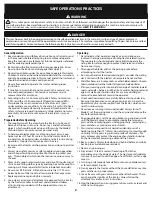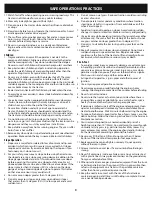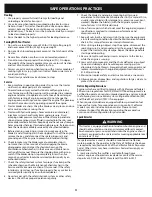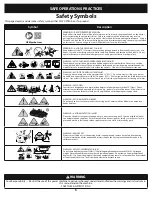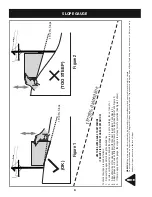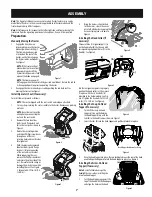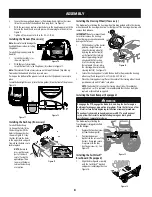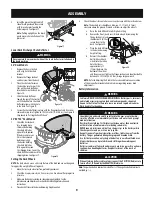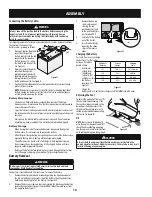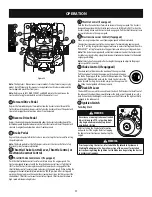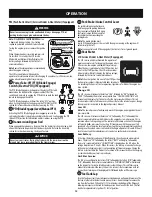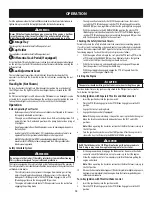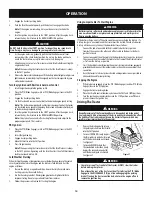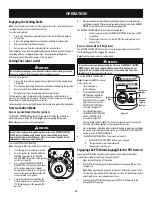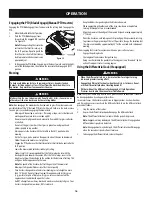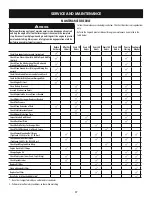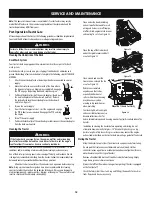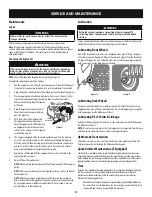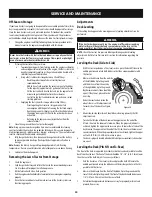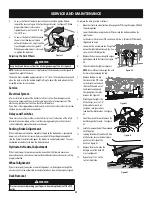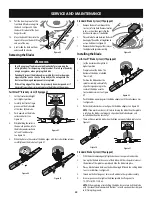
7
ASSEMBLY
Note:
This Operator’s Manual covers several models. Tractor features may vary by
model. Not all features in this manual are applicable to all tractor models and the
tractor depicted may differ from yours.
Note:
All references in this manual to the left or right side and front or back of the
tractor are from the operating position only. Exceptions, if any, will be specified.
Preparation
Manually Moving the Tractor
1.
Engage the transmission
bypass rod to move the tractor
manually without starting it.
The transmission bypass rod
is located on the rear of the
tractor, on the frame. Engage
the bypass rod by pulling out.
See Figure 1.
NOTE:
If the tractor will not
move or does not move freely
when pushing check if the
hydrostatic bypass rod is fully
open or the brake is engaged.
NOTE:
The transmission will
NOT engage when the hydrostatic bypass rod is pulled out. Return the rod to
its disengaged position prior to operating the tractor.
2.
Disengage the transmission bypass rod by pushing the rod back in after
moving the tractor. See Figure 1.
Install Operator’s Seat (If necessary)
To install the seat proceed as follows:
NOTE:
The seat is shipped with the seat switch and seat pan attached.
1.
Cut any straps securing the seat assembly to the tractor. Remove any packing
material.
NOTE:
Be careful not to cut the
wiring harness connecting the
seat and the seat switch.
2.
Remove the two shoulder
bolts (a) and flange lock nuts
(b) in the seat pan as shown in
Figure 2.
3.
Rotate the seat into position
and slide a Phillips screwdriver
through one of the seat-
securing holes and seat bracket
for alignment.
4.
With the previously removed
shoulder bolts (a) and flange
lock nuts (b) secure one side
of the seat and seat bracket.
While supporting the seat,
remove the Phillips screwdriver
and secure the other side of the
seat. Be careful not to crimp or
damage the wire harness while
installing the seat. See Figure
3. Torque to 84-103 in-lbs (9.5-
11.6 N-m).
Figure 1
(a)
(a)
(b)
(b)
Figure 2
(a)
(b)
(a)
(b)
Figure 3
5.
Using the harness clip attached
to the harness, secure the excess
wire to the fender by snapping the
harness clip in place as shown in
Figure 4.
Installing the Hood Collar (If
necessary)
There are three (3) alignment posts (a)
on the hood collar (b) that line up with
corresponding alignment holes (c) in the
hood (d). See Figure 5
(a)
(a)
(a)
(a)
(b)
(c)
(c)
(c)
(d)
Figure 5
Use these alignment points to properly
position the hood collar (a), then secure
it in place with the six hex bolts (b)
provided in the hardware bag. See Fig-
ure 8. Tighten the hex bolts to 102-124
in-lbs (11.5-14 N-m). See Figure 6.
Installing the Snap-On Hood
Topper (If necessary)
1.
To install the snap-on hood
topper (a), line up the holes on
the hood topper (a) up with the
tabs (b) in the hood frame as shown in Figure 7.
2.
Insert the tabs (b) into the hood topper and pull back to lock into place.
3.
Once the hood topper is in place, the two locking tabs near the rear of the hood
need to be pushed upward to lock the hood topper in place. See Figure 8.
Installing the Screw-On Hood
Topper (If necessary)
Note:
Be careful not to damage the
headlight harness when installing the
screw-on hood topper.
1.
Set the hood topper up against the
top of the hood with the hood open,
and align the holes on the hood.
Figure 4
b
a
b
b
b
Figure 6
(a)
(b)
(b)
(b)
(b)
Figure 7
Hood Topper Not Shown for Clarity
Figure 8
(a)
(b)
(b)
(d)
(c)
(d)
Figure 9


